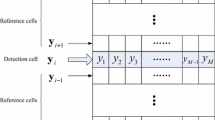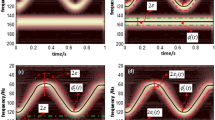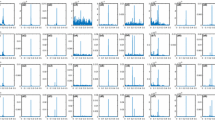Abstract
Aiming at the problem of insufficient detection ability of weak harmonic signals under the background of chaotic noise, a method for detecting weak harmonic signals using empirical likelihood ratio (ELR) is proposed. First, the problem of detecting weak harmonic signals in a chaotic background is transformed into a test of heteroscedasticity hypothesis in a chaotic background. Then, based on the sensitivity of chaotic signal to initial value and short-term predictability, the phase space of observation signal is reconstructed, and the chaotic linear prediction model (CLP model) is established. The mean square error, mean absolute error, and root mean square error are used as the evaluation criteria for the chaotic linear prediction model. Then, an estimation equation is established according to the CLP model, and the existence of harmonic signals is tested by the ELR method. The method of sequential quadratic programming is used to optimize the model parameters, and the chi-square distribution is used to judge whether there are harmonic signals, so as to detect the weak harmonic signals submerged in the background of chaotic noise. Finally, Lorenz system was used as the background of chaotic noise for simulation experiments. The experimental results showed that the weak harmonic signals in the chaotic background could still be detected when the SNR was − 72.801 dB, which was more effective than the traditional method.





Similar content being viewed by others
Data Availability
No data were used to support this study.
References
Wang, G., & Chen, D. (1999). The application of chaotic oscillators to weak signal detection. IEEE Transactions on Industrial Electronics., 46(2), 440–444.
Xin, Z., Hao, Q., Wang, K., Yi, S., & Hu, H. (2018). An investigation on acoustic emission detection of rail crack in actual application by chaos theory with improved feature detection method. Journal of Sound and Vibration., 436, 165–182. https://doi.org/10.1016/j.jsv.2018.09.014
Su, L., Sun, H. H., & Wang, J. (2017). Detection and estimation of weak pulse signal in chaotic background noise. Acta Physica Sinica., 66(9), 090503. https://doi.org/10.7498/aps.66.090503
Xiong, L., Qi, L., Teng, S., Wang, Q., Wang, L., & Zhang, X. (2021). A simplest Lorenz-like chaotic circuit and its applications in secure communication and weak signal detection. The European Physical Journal Special Topics, 230(7), 1933–1944.
Su, L., Li, M., & Zhao, S. (2021). Distributed sensor local linear fusion detection of weak pulse signal in chaotic background. Journal of Sensors, 2021(1), 1–11.
Zhao, Z., & Yang, S. (2015). Application of van der Pol-Duffing oscillator in weak signal detection. Computers & Electrical Engineering., 41, 1–8.
Kang, J., Jiang, Y., Li, R., et al. (2019). Sensitive elemental analysis with high repetition rate laser-ablation spark-induced breakdown spectroscopy combined with lock-in signal detection. Spectrochimica Acta Part B: Atomic Spectroscopy., 155, 50–55.
He, B., Huang, Y., & Wang, D. (2019). A parameter-adaptive stochastic resonance based on whale optimization algorithm for weak signal detection for rotating machinery. Measurement, 136, 658–667.
Wernitz, B. A., & Hoffmann, N. P. (2012). Recurrence analysis and phase space reconstruction of irregular vibration in friction brakes: Signatures of chaos in steady sliding. Journal of Sound and Vibration., 331(16), 3887–3896.
Li, M., Geng, J. H. D., & Zheng, T. (2016). Ship motion prediction using dynamic seasonal RvSVR with phase space reconstruction and the chaos adaptive efficient FOA. Neurocomputing, 174(4), 661–680.
Su, L., Deng, L., Zhu, W., & Zhao, S. (2020). Statistical detection of weak pulse signal under chaotic noise based on elman neural network. Wireless Communications and Mobile Computing., 2020(1), 1–12.
Lai, H., & Leng, G. (2016). Weak-signal detection based on the stochastic resonance of bistable Duffing oscillator and its application in incipient fault diagnosis. Mechanical Systems and Signal Processing, 81, 60–74.
Liu, S., Ma, H., Zhang, Y., et al. (2016). Chaos characteristics and least squares support vector machines based online pipeline small leakages detection. Chaos, Solitons & Fractals., 91, 656–669.
Gokyildirim, A., Uyaroglu, Y., & Pehlivan, I. (2016). A novel chaotic attractor and its weak signal detection application. Optik - International Journal for Light and Electron Optics., 127(19), 7889–7895.
Wu, J., Wang, H., Sun, X., & Liu, Y. (2014). Pure harmonics extracting from time-varying power signal based on improved empirical mode decomposition. Measurement, 49, 216–225. https://doi.org/10.1016/j.measurement.2013.11.041
Su, L., & Li, C. (2017). Extracting narrow-band signal from a chaotic background with LLVCR. Wireless Personal Communications, 96(2), 1907–1927.
Su, L., & Li, C. (2017). Extracting harmonic signal from a chaotic background with local linear model. Mechanical Systems and Signal Processing, 84, 499–515.
Khodabakhshian, A., Pour, M. E., & Hooshmand, R. (2012). Design of a robust load frequency control using sequential quadratic programming technique. International Journal of Electrical Power & Energy Systems., 40(1), 1–8.
Hassanien, A., Sergiy, V., & KonMax, W. (2008). Robust adaptive beamforming using sequential quadratic programming: an iterative solution to the mismatch problem. IEEE Signal Processing Letters, 15, 733–736.
Owen, A. (1991). Empirical likelihood for linear models. The Annals of Statistics, 19(4), 1725–1747.
Hua, L., & Yongsong, Q. (2008). Empirical likelihood based inferences for partially linear models with missing covariates. Australian & New Zealand Journal of Statistics., 50(4), 347–359.
Heung, W., Feng, L., Min, C., & Cheungip, W. (2009). Empirical likelihood based diagnostics for heteroscedasticity in partial linear models. Computational Statistics & Data Analysis., 53(9), 3466–3477. https://doi.org/10.1016/j.csda.2009.02.029
Li, D., & Jianxin, P. (2013). Empirical likelihood for generalized linear models with longitudinal data. Journal of Multivariate Analysis., 114, 63–73.
Takens, F. (1980). Detecting strange attractors in turbulence. Lecture Notes in Mathematics., 898(1), 336–381.
Xu, P. (2009). Differential phase space reconstructed for chaotic time series. Applied Mathematical Modelling., 33(2), 999–1013.
Cao, L. (1997). Practical method for determining the minimum embedding dimension of a scalar time series. Physica D: Nonlinear Phenomena, 110(1–2), 43–50.
Owen, A. (1990). Empirical likelihood ratio confidence regions. Annals of Statistics, 18(1), 90–120.
Wong, H., Feng, L., Min, C., & Cheungip, W. (2009). Empirical likelihood based diagnostics for heteroscedasticity in partially linear errors-in-variables models. Journal of Statistical Planning & Inference., 139(3), 916–929.
Zhang, J., Xiaojun, W., Yumei, Z., & Jingjing, L. (2016). A chaotic time series prediction model for speech signal encoding based on genetic programming. Applied Soft Computing., 38, 754–761.
Feng, G., Lin, L., & Chen, W. (2016). Novel continuous function prediction model using an improved Takagi-Sugeno fuzzy rule and its application based on chaotic time series. Engineering Applications of Artificial Intelligence., 55, 155–164.
Lin, H., Yue, L., & Yang, B. (2004). The neural network method for detecting weak harmonic signal embedded in chaos. Journal of Communications, 2004(05), 75–82.
Acknowledgements
This paper was supported by was funded by the Natural Science Project of CQ CSTC of China (Grant No. cstc2018jcyjAX0464).
Funding
Natural Science Foundation Project of Chongqing,Chongqing Science and Technology Commission (CN), Grant No. (cstc2018jcyjAX0464).
Author information
Authors and Affiliations
Corresponding author
Ethics declarations
Conflict of interest
The authors declare that there are no conflicts of interest regarding the publication of this paper.
Additional information
Publisher's Note
Springer Nature remains neutral with regard to jurisdictional claims in published maps and institutional affiliations.
Rights and permissions
About this article
Cite this article
Su, L., Zhu, W., Ling, X. et al. Weak Harmonic Signal Detecting in Chaotic Noise Based on Empirical Likelihood Ratio. Wireless Pers Commun 126, 335–350 (2022). https://doi.org/10.1007/s11277-022-09747-2
Accepted:
Published:
Issue Date:
DOI: https://doi.org/10.1007/s11277-022-09747-2




